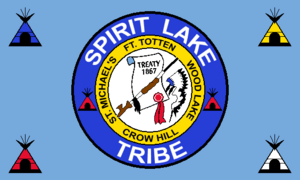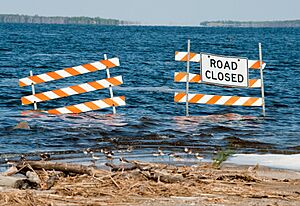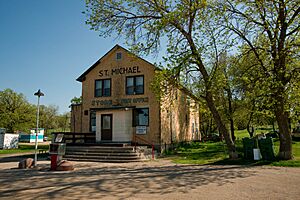Spirit Lake Tribe facts for kids
| Mni Wakan Oyate | |
|---|---|

Flag of the Spirit Lake Tribe
|
|

Location of Spirit Lake Reservation
|
|
| Total population | |
| 7,256 enrolled members | |
| Regions with significant populations | |
| Languages | |
| English, Dakota | |
| Religion | |
| Christianity (incl. syncretistic forms), Midewiwin | |
| Related ethnic groups | |
| Assiniboine, Stoney (Nakoda), and other Siouan peoples |
The Spirit Lake Tribe is a Native American tribe. They are also known as Mni Wakan Oyate in their own Dakota language. This tribe is officially recognized by the United States government.
Their home is the Spirit Lake Dakota Reservation. It is located in east-central North Dakota. The reservation sits on the southern shores of Devils Lake. The tribe is made up of different groups of Dakota, including the Pabaksa, Sisseton, and Wahpeton bands.
The reservation was created in 1867. This happened through a treaty between the Sisseton-Wahpeton Bands and the U.S. government. The land covers about 1,284 square kilometers (496 square miles). Most of it is in Benson and Eddy counties. Some smaller parts are in Ramsey, Wells, and Nelson counties.
In 2014, the tribe had 7,256 official members. In 2010, about 3,587 tribal members lived on the reservation. The largest town on the reservation is Fort Totten.
Contents
Understanding the Tribe's Name
The Spirit Lake Tribe was once called the Devils Lake Sioux Tribe. Their reservation was known as the Fort Totten Indian Reservation. In the 1970s, they briefly changed their name. This caused some confusion with another tribe in South Dakota. In 1993, they officially became the Spirit Lake Tribe.
The name "Devils Lake" comes from the Dakota words mni (water) and wak’áŋ (spirit or sacred). The Dakota people believe the lake is holy. They think it is home to a special underwater serpent called Unktehi. The town of Minnewaukan also gets its name from these Dakota words.
Early European-American settlers misunderstood the name. They thought "Bad Spirit Lake" or "Devils Lake" meant something evil. But "bad" actually referred to the lake's salty water, which was not good for drinking. "Spirit" meant the mirages often seen over the water. The Dakota people do not have the same idea of a "devil" as in Christian beliefs.
The Environment Around Spirit Lake
The Spirit Lake Tribe's reservation is on the southern shore of Devils Lake. This area has always been important to the Dakota people. The Sisseton, Wahpeton, and Cut-Head bands moved to this reservation. This happened after the 1867 treaty. The treaty was for Dakota people who were not forced to move to other reservations.
Devils Lake is a "closed-basin" lake. This means water flows into it but not out. Because of this, the reservation has faced many floods since the 1990s. These floods have damaged homes, land, and businesses. The tribal leader, Myra Pearson, asked President Barack Obama for help.
Since then, tribal leaders have worked with a special group. This group includes officials from the Federal Emergency Management Agency (FEMA). They created a plan in 2010 to help the tribe recover. This plan includes ways to fight flooding and also to help the tribe's economy and culture.
Spirit Lake Communities
Fort Totten is the main center for the reservation's economy and government. The tribal offices are there, along with the tribal college. The tribe also has a program to help members find jobs.
The reservation has several districts:
- Crow Hill District, Crow Hill, North Dakota
- Fort Totten District, Fort Totten, North Dakota
- Mission District, St. Michael, North Dakota
- Woodlake District, Tokio, North Dakota
Long ago, different Dakota bands had villages in these areas. For example, the Wahpeton bands lived near Warwick, ND. The Sisituwan bands lived where St. Michael is today.
The Tribe's Economy
The Spirit Lake Tribe owns a company called Sioux Manufacturing Corporation. This company makes special armor materials. It is one of the oldest businesses fully owned by a Native American tribe. It started in 1973. By 1989, the tribe owned the whole company.
Today, 75% of the workers are Native American. They make products for the United States Department of Defense. Their factory is very large, covering 250,000 square feet.
Visitors can also enjoy other places on the reservation. These include the White Horse Hill National Game Preserve. There is also the Fort Totten State Historic Site. This site is listed on the National Register of Historic Places.
The Spirit Lake Tribe also runs Cankdeska Cikana Community College. This is a tribal college that opened in the 1970s. It offers two-year programs. These programs help students get jobs and learn more about their Dakota culture and language. The radio station KABU 90.7 serves the Spirit Lake tribe.
Spirit Lake Casino and Resort
Since the late 1900s, the tribe has used gaming to earn money. This money helps support the tribal community. The first casino opened in St. Michael, North Dakota. This happened after the Indian Gaming Regulatory Act was passed in 1988. The tribe signed an agreement with the Governor of North Dakota.
The first casino hired 35 people, mostly tribal members. In 1994, the tribe opened a second casino in Tokio, ND. This created 191 jobs. In 1996, the tribe closed both smaller casinos. They invested $7 million to open a new, larger casino.
The current Spirit Lake Casino and Resort is owned and run by the tribe. It is located in St. Michael, North Dakota. The casino has brought new income and helped the tribe's economy. It employs over 300 people, with 75% being Native American.
The resort is very large. It has 82,000 square feet for gaming and entertainment. It also has 112,300 square feet for the resort and hotel. It is on an island connected by a road. The resort has almost 150 hotel rooms. It also has a 1,000-seat auditorium and a banquet hall. There is an RV park, a gift shop, and a four-story water park. In 2011, more jobs were added. The Spirit Lake Marina and a grocery store opened at the casino grounds. The marina hosts a fishing tournament every summer.





